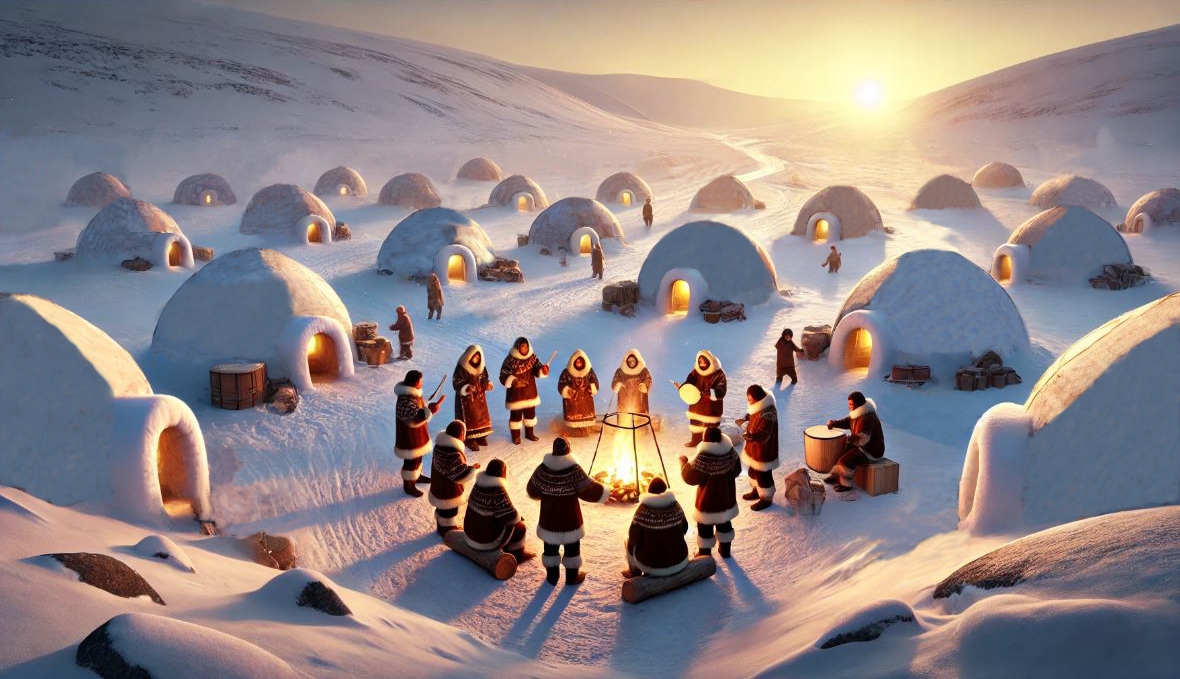The Arctic winter is a season of magic and endurance for Inuit communities across Greenland, Canada, and Alaska. Far from the commercial hustle of many holiday traditions, Inuit celebrations of Christmas and New Year embody a deep connection with the land, community, and spiritual practices. Among the most distinctive celebrations is The Arctic winter is a season of magic and endurance for Inuit communities across Greenland, Canada, and Alaska. Far from the commercial hustle of many holiday traditions, Inuit celebrations of Christmas and New Year embody a deep connection with the land, community, and spiritual practices. Among the most distinctive celebrations is Quviasukvik, the Inuit winter festival, which coincides with the return of the sun and new year celebrations in January, embracing the cycles of nature and survival.

Quviasukvik: The Inuit Winter Festival
Inuit celebrations around the Christmas season are often intertwined with Quviasukvik, which translates to "happy day." This winter festival is thought to have roots in pre-Christian traditions and symbolizes renewal, gratitude, and communal joy. Quviasukvik celebrates the long winter’s end, welcoming the lengthening of daylight and the promise of new life with warmth and togetherness.
Historically, this season was a time to share food stores and exchange handmade gifts. The community gathered, sharing stories and songs, often around fires, to drive away the darkness and cold of the long Arctic nights. During these gatherings, families would feast on local foods, such as seal, whale, and caribou, and honor the spirit of sharing that defines Inuit survival in harsh environments.
Christmas Traditions in Inuit Culture
As Christian influences mingled with Inuit traditions, Christmas took on its own Arctic form. In many Inuit communities today, Christmas Eve and Christmas Day are marked by church services and carol singing, alongside unique Inuit holiday customs.
In Greenland, for example, families decorate their homes with candles and stars. Large gatherings take place, where community members share in songs, drum dancing, and kaffemik—a traditional celebration with coffee, cakes, and sweets. In some areas, Santa is said to reside in Greenland, adding a northern touch to the holiday spirit. The mingling of Christmas with Inuit traditions has brought new forms of togetherness, making it a beloved time for all ages.
The Nalujuit: A Chilling Tradition in Labrador
One of the more striking Inuit Christmas-time traditions is the appearance of the Nalujuit in Labrador Inuit culture. Similar to figures like Krampus in Alpine folklore, Nalujuit are frightening figures dressed in ragged furs and masks, arriving on New Year's Eve. They visit children’s homes, intending to scare them, but also to remind them of the importance of good behavior and respect for community values. Despite their intimidating appearance, the Nalujuit embody a protective spirit, teaching young ones about discipline and courage.
Children know the Nalujuit represent both punishment and protection, reinforcing the values of cooperation and respect that are central to Inuit survival. This tradition, shared through generations, adds an element of mystery and cultural depth to the holiday season.
Welcoming the New Year with Gratitude and Renewal
For Inuit communities, the New Year represents a time to honor survival and to express gratitude. As daylight begins to increase after the winter solstice, Inuit families celebrate Quviasukvik once again, not only as a joyful winter festival but as a symbolic return of life and light. Families may gather for meals, storytelling, and games, reflecting on the year behind them and the promise of the year ahead. Inuit New Year traditions celebrate unity and resilience, where joy, gratitude, and respect for the environment remain central themes.
An article written by Fanney Sigrún Ingvadóttir
Related news:
Jólasveinar - The thirteen Icelandic Yule lads (Santa Clauses)
Jólasveinar - the Icelandic Yule lads (Santa clauses)!
Arctic Christmas, Christianity and beliefs
Quick-facts:
The thirteen Icelandic Yule Lads
The tags below provide an opportunity to view previously posted related news within the selected category

